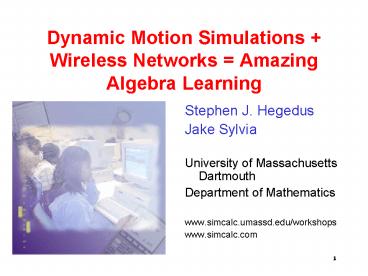Dynamic Motion Simulations Wireless Networks Amazing Algebra Learning
1 / 15
Title:
Dynamic Motion Simulations Wireless Networks Amazing Algebra Learning
Description:
Classroom Connectivity (in the form of TI Navigator) 5. Plan for the Session ... Exploit connectivity across device types ... How Do We Exploit Connectivity? ... –
Number of Views:71
Avg rating:3.0/5.0
Title: Dynamic Motion Simulations Wireless Networks Amazing Algebra Learning
1
Dynamic Motion Simulations Wireless Networks
Amazing Algebra Learning
- Stephen J. Hegedus
- Jake Sylvia
- University of Massachusetts Dartmouth
- Department of Mathematics
- www.simcalc.umassd.edu/workshops
- www.simcalc.com
2
Our friend and colleague
3
Big Picture Combine dynamic SimCalc
representations with the new ingredient,
Classroom Connectivity (CC) that is
4
Dynamical Mathematics (in the form of SimCalc
MathWorlds) Classroom Connectivity (in the form
of TI Navigator)
5
Plan for the Session
- Orient ourselves to the bigger picture goals
- Do some warm-up MathWorlds activities to get a
feel for Mathworlds on the TI-83 (CMW) - Use CMW to make, Navigator to collect, and JMW to
examine individual mathematical constructions - Use CMW to make, Navigator to collect, and JMW to
aggregate parametrically varying functions - Step back and reflect on what we have been doing
- Plan for future interactions
6
Our Larger Goals
- Integrate two families of technologies (SimCalc
Navigator) to achieve uniquely powerful
educational advantage for students - Exploit connectivity across device types
- To take advantage of the strengths of each to
compensate for weaknesses of the other, and - To create learning and teaching opportunities
that transcend the powers of each
7
Technologically, What Is Happening?
- We have a common data-structure across computer
and hand-held versions of SimCalc MathWorlds
(Calculator MW Java MW) - We integrate with Navigators communication
infrastructure to move data (especially
MathWorlds functions) between device-types
8
A SimCalc AssumptionMath Needs to Be About
Something
9
Basic SimCalc Features
- Dynamic simulations hot-linked to graphs
formulas (which are about the motions) - Graphically definable editable functions,
including piecewise-defined functions - Import re-animate CBR/L motion data
- Visualization tools (e.g., dropping marks
during motions) - Hot-linked rate accumulation data (e.g.,
velocity position)
10
How Do We Exploit Connectivity?
- Facilitate work-flow to from students
activities, assessments, homework, etc. - Make individual mathematical constructions
public, e.g., mathematical performances - Aggregate student constructions to
- Vary essential parameters on a per-student basis
- Elevate student attention from single objects to
parametrized families of objects - Provide opportunity for generalization across
cases - Expose common thought-patterns (e.g., errors)
11
So lets try a few things! Well then return
reflect.
12
Strategically, What Are We Doing?
- We enable the teacher to render an individuals
mathematical activity public in a shared display - We interlink mathematical structures and
classroom social structures (both designed and
naturally occurring) to create new forms of
learning, new activity structures - We intensify, focus manage student attention
- We promote the infusion of personal social
identity in students mathematical constructions
13
Reflections on the Projection-of-Identity Into
the Public Space
- Each person/group is up there (no place to
hide) - What is given what is hidden is tightly
manipulable to serve a wide range of pedagogical
curricular aims - Personal identity is projected into the public
object - Attention can be explicitly managed by the
teacher by showing/hiding/grouping students
constructions - Classroom is infused with affect social
authenticity - The above features in combination enable the
teacher to enhance the intensity of classroom
learning in new ways
14
CD Contents Sample Lessons from theAlgebra
Subscription Sample Lessons from the forthcoming
Connected MathWorlds Subscription
15
Thank You!
- Contact Stephen Hegedus (shegedus_at_umassd.edu)
- www.simcalc.umassd.edu/workshops
- www.simcalc.com
- To download more free stuff





























